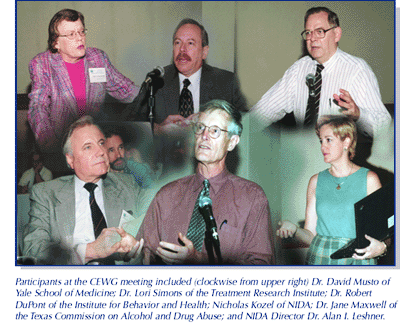
This June, NIDA’s Community Epidemiology Work Group (CEWG) celebrated 25 years of providing timely and accurate information about drug abuse patterns, trends, and emerging problems. The network of drug abuse experts was established in 1976 and meets twice a year to assess local drug use trends in 20 metropolitan areas and the State of Texas and what they portend for the Nation.
NIDA Director Dr. Alan I. Leshner saluted the group during its recent 4-day meeting. “CEWG has identified every major national drug abuse trend in the making,” he said. “We mounted our recent club drug and prescription drug initiatives because you told us there was a problem. Your localized reports about drug abuse are invaluable in our efforts to address emerging drug crises.”
Nicholas Kozel of NIDA’s Division of Epidemiology, Services and Prevention Research has coordinated the group since its beginning. CEWG started with researchers from 15 cities; today the group includes researchers from 21 areas. (See “Drug Abuse Data from the Nation’s Communities”) Specific information sources that CEWG members analyze include treatment and mortality data from local and State agencies; the Substance Abuse and Mental Health Services Administration’s (SAMHSA) Drug Abuse Warning Network (DAWN); the National Institute of Justice’s (NIJ) Arrestee Drug Abuse Monitoring (ADAM) System; seizure, price, purity, prescription/distribution, and arrest data from the Drug Enforcement Administration (DEA) and State and local law enforcement agencies; and information from ethnographic studies and focus groups.
In its early years, CEWG focused on heroin, which at the time was the most serious drug problem in the United States. Researchers profiled the epidemic in terms of heroin-related deaths, emergency room cases, and treatment admissions, as well as heroin-related arrests, hepatitis B incidence, and street-level prices and purity of the drug. As the group refined its reporting procedures, members from around the country began reporting on other emerging drug problems such as marijuana, crack cocaine, and, more recently, MDMA and other club drugs.
By the early 1980s, the value of CEWG was well established. Representatives from the Food and Drug Administration, the Centers for Disease Control and Prevention, the Department of State, DEA, NIJ, the National Drug Intelligence Center, and SAMHSA’s Office of Applied Studies were invited to attend CEWG meetings.
Since 1984, NIDA has been providing technical assistance to States in planning, conducting, and establishing State epidemiology work groups to collect and analyze local drug abuse data. In the 1990s, NIDA began to provide technical assistance and support to implement qualitative research methods such as focus groups and ethnographic reports, which provide descriptive information. “CEWG is unique at NIDA,” Mr. Kozel notes, “in its use of both qualitative and quantitative research methods.”
The influence of CEWG has crossed national borders as well. In addition to regular attendees Canada and Mexico, this year’s meeting featured representatives from Singapore, Malaysia, Indonesia, and South Africa. Israeli and Palestinian social scientists also traveled to the meeting as part of their work together to set up a joint surveillance system modeled on the CEWG in their communities. Since CEWG’s inception, every continent except Antarctica has been represented at its meetings. The CEWG model has spawned epidemiology work groups around the globe, most recently in South Africa.
